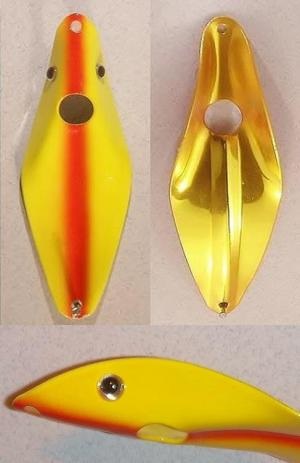 Targeting redfish, speckled trout, snook and flounder in the saline shallows is commonly an exercise in covering, and subsequently eliminating water. True, it’s tough to beat a live shrimp, croaker or crab under a popping-cork once you have fish pinned in a corner. But until then, you’re best off peppering the water with exploratory casts, deploying a menagerie of lures, including casting spoons.
Targeting redfish, speckled trout, snook and flounder in the saline shallows is commonly an exercise in covering, and subsequently eliminating water. True, it’s tough to beat a live shrimp, croaker or crab under a popping-cork once you have fish pinned in a corner. But until then, you’re best off peppering the water with exploratory casts, deploying a menagerie of lures, including casting spoons.
Some will argue that saltwater spoons remain the most reliable search baits. Even in this time of spitting-image replication – hard and soft-baits cloned to look, even act like real forage – the stalwart swim and flash of the spoon is everlastingly effective.
The trouble with most spoons, however, is their one-dimensional performance. A good and heavy, long casting spoon, for example, is a bull in a China shop in the shallows. It crashes and cartwheels over oyster beds, inevitably becoming a permanent fixture notched in the reef. Super-skinny, lightweight spoons tango tantalizingly over the shallows, but can only be cast about six oar lengths, even less in a headwind.
 The good news is that a high-performing and fully adaptable spoon does exist; one that can cast across the marsh yet hover among tailing redfish long enough to get annihilated. This spoon of spoons is the Fin-Wing.
The good news is that a high-performing and fully adaptable spoon does exist; one that can cast across the marsh yet hover among tailing redfish long enough to get annihilated. This spoon of spoons is the Fin-Wing.
This so-called “hovering” serves as a primo example of Fin-Wing functionality. Typecasting says saltwater lures, including spoons, should be burnt at Formula One speeds. Yes, inshore species often react positively to a fast-paced retrieve. But equally as often, inshore species either aren’t chasing the silver bullet, or simply didn’t have time to commit, especially in the hyper-shallows.
Because of Fin-Wing’s inimitable scooped shape and wide profile, the patented spoon has an especially long hang-time, and can be retrieved slower. This keeps the bait in the strike-zone longer, letting fish dial-it-up for a charge, not to mention summoning nearby fish that would have gone completely untapped by a fast moving – and sinking – conventional spoon.
Another Fin-Wing phenomenon is its subsurface appeal. As desperately as inshore anglers want to taste a topwater bite, sometimes that just isn’t happening. The typical backup program involves pitching a jig. Retrieved at the right speed, the Fin-Wing flounces just below the surface, throwing flash and vibe like a salsa dancer. So sit on that jig for a while and let the Fin-Wing shake its hips below the surface.
Here’s your chance to get reacquainted with spooning. Take a few Fin-Wings on your next inshore adventure and reap the catch of the most progressive piece of metal on the Seven Seas.
| ABOUT
A symbol of American ingenuity and hard work, the Fin-Wing® design has been catching fish of all stripes since 1948. Today, the lure is the pride of Keweenaw Tackle Company; built in the Copper Country to the same rigid standards as the handmade original, using only the highest-quality materials and superior long-lasting finishes. Find out more and see the lure in action at www.keweenawtc.com. |
